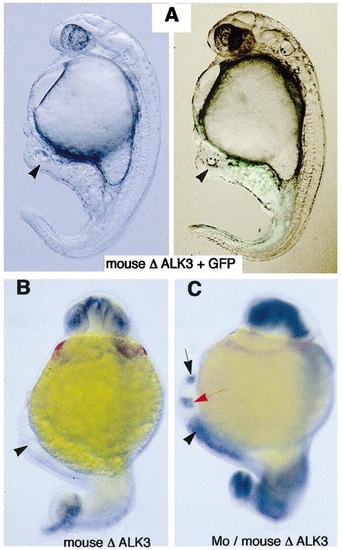Fig. 11
|
admp antagonizes organizer formation and maintenance. (A, B) Injection of mouse Δ-alk3 RNA at the 16-cell stage into one marginal blastomere leads to induction of a partial secondary axis. Arrowheads, otic vesicles. (A) Bright-field and epifluorescence images are shown side by side. The use of NLS-GFP as a lineage tracer reveals the induced axis. (B, C) In situ hybridization with pax6, her5, and myoD probes in dark blue, hgg1 in red. (C) admp-morpholino injection at the one-cell stage followed by mouse Δ-alk3 RNA injection at the 16-cell stage leads to induction of a partial secondary axis with forebrain structures. The forebrain stained with pax6 (black arrow) and midbrain–hindbrain boundary stained with her5 (red arrow) are indicated. |
Reprinted from Developmental Biology, 241(1), Willot, V., Mathieu, J., Lu, Y., Schmid, B., Sidi, S., Yan, Y.-L., Postlethwait, J.H., Mullins, M., Rosa, F., and Peyriéras, N., Cooperative action of ADMP- and BMP-mediated pathways in regulating cell fates in the zebrafish gastrula, 59-78, Copyright (2002) with permission from Elsevier. Full text @ Dev. Biol.

